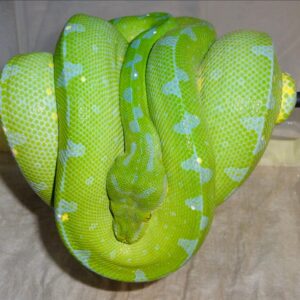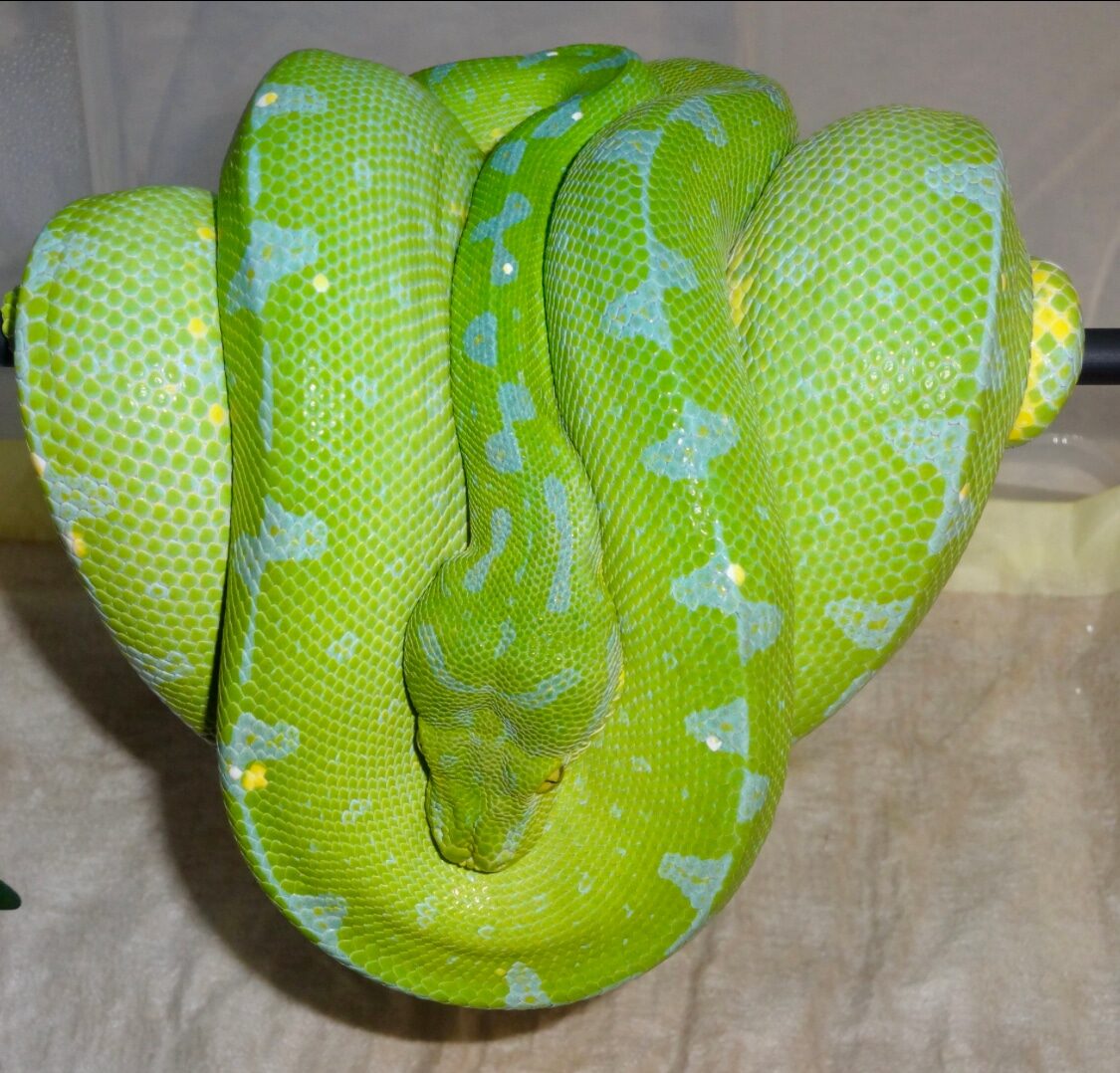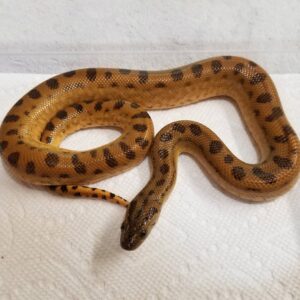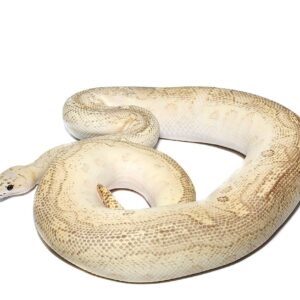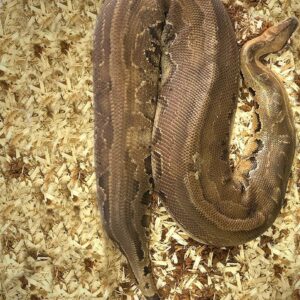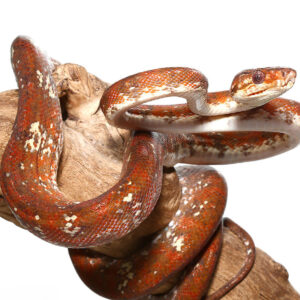Sorong Green Tree Python For Sale
$649.99
SORONG GREEN TREE PYTHON
When discussing localities and race that belong to Green Tree Pythons, it is crucial to take into consideration the geographical barriers that exist in the area.
In the Papua New Guinea mainland is divided into small pockets made up of Chondro habitats by the central mountain range, which is at a minimum impedes the interbreeding between communities and allows them to evolve in isolated.
In general, we can say that there are distinct cultural differences between northern and western mainland communities that differ to the characteristics of the south and south-west.
Sorong Green Tree Python of The Vogelkop Peninsula, and Raja Ampat regions in western Indonesian New Guinea are commonly called “Sorong type” in reference to the largest city of the region.
Sorong Green Tree Python can be identified by a nearly unbroken blue dorsal line that is accompanied by blue triangle patterns both sides of this line. Blue spots can be visible on the animals’ sides, and white scales could be seen.
Their tails are typically longer and have a higher degree of taper than other species and can be black or blue at the tip. The hatchlings may be yellow or red with darker stripes on the dorsal line.
It has become common in Australia to have any animal that shows indications that are blue, to be classified Sorong sort of animal (or wrongly Sarong kind). A lot of the animals that are labelled Sorong type are actually mixed locality , and don’t exhibit the traits associated with Sorong location type.
Description
Sorong Green Tree Python
The Sorong Green Tree Python, scientifically known as Morelia viridis, is a fascinating species originating from the Sorong region of Indonesia. This captivating reptile has garnered significant attention among reptile enthusiasts due to its striking appearance and distinctive behavioral traits. A member of the Pythonidae family, the Sorong Green Tree Python is renowned for its vibrant green coloration, which often features a mix of yellow, blue, and white markings, making it a visually stunning specimen.
One of the most remarkable characteristics of the Sorong Green Tree Python is its arboreal lifestyle. These pythons are primarily tree-dwelling, utilizing their prehensile tails to navigate and secure themselves among the branches. This adaptation not only aids in hunting but also provides a strategic advantage in avoiding ground-based predators. Their long, slender bodies and muscular build enable them to move gracefully through the trees, further adding to their allure.
In addition to their physical beauty, Sorong Green Tree Pythons exhibit intriguing behavioral patterns. They are known for their ambush predation technique, where they remain motionless and well-camouflaged among the foliage, striking with precision when prey ventures too close. This hunting strategy is facilitated by their heat-sensing pits located along the upper lip, allowing them to detect warm-blooded prey even in low light conditions.
The popularity of the Sorong Green Tree Python among reptile enthusiasts can be attributed to its exotic appearance and relatively manageable size, typically reaching 3 to 5 feet in length. These pythons are also known for their calm demeanor when properly handled, making them a suitable choice for experienced keepers. However, their specific husbandry requirements, such as maintaining high humidity levels and ensuring adequate vertical space for climbing, necessitate a well-informed approach to their care.
Overall, the Sorong Green Tree Python stands out as a captivating and enigmatic species, admired for its stunning aesthetics and unique arboreal habits. Its presence in the reptile community continues to inspire fascination and dedication among hobbyists and professionals alike.
The Sorong Green Tree Python (Morelia viridis) is native to the lush rainforests of New Guinea and the surrounding islands. This vibrant species is particularly prevalent in the Sorong region of West Papua, Indonesia, from which it derives its name. New Guinea’s tropical climate provides an ideal environment for these pythons, characterized by high humidity and consistently warm temperatures throughout the year.
These arboreal snakes are most commonly found in lowland rainforests, where the dense canopy offers ample opportunities for climbing and hunting. The Sorong Green Tree Python thrives in environments where humidity levels remain between 70% and 80%, and temperatures range from 75°F to 85°F (24°C to 29°C). This specific climatic condition is crucial for their overall health and well-being, as it supports their respiratory and reproductive systems.
In their natural habitat, Sorong Green Tree Pythons are typically located in areas abundant with a variety of trees and plants. They display a preference for trees with thick foliage, which provide them with the necessary cover to camouflage from predators and to efficiently ambush prey. These pythons are often seen coiled around branches, allowing them to remain inconspicuous while waiting for unsuspecting birds and small mammals to pass by.
The vegetation in their habitat typically includes a mix of tall trees, shrubs, and vines, offering a complex and multi-layered environment. This intricate habitat structure not only supports their predatory habits but also facilitates their sheltering needs. The abundant plant life contributes to maintaining the humid microclimate that is essential for their survival.
Understanding the natural environment of the Sorong Green Tree Python is pivotal for anyone interested in their conservation or care in captivity. Replicating these conditions as closely as possible is crucial to ensuring the health and longevity of these fascinating reptiles.
Physical Characteristics
The Sorong Green Tree Python, a visually striking reptile, is renowned for its vibrant green coloration adorned with blue markings. These snakes typically grow to a length of 4 to 6 feet, making them medium-sized compared to other python species. The weight of an adult Sorong Green Tree Python generally ranges from 1.5 to 2.5 pounds, with males being slightly smaller and lighter than females.
One of the most captivating features of the Sorong Green Tree Python is its sexual dimorphism. Males and females exhibit slight differences in size and coloration, with males often showcasing a more pronounced blue hue along their dorsal scales. The scale texture of these pythons is smooth and glossy, aiding in their arboreal lifestyle by reducing friction as they navigate through tree branches.
In terms of lifespan, Sorong Green Tree Pythons can live up to 20 years in captivity when provided with optimal care. In the wild, however, their lifespan is generally shorter, averaging around 10 to 15 years. Factors such as predation, disease, and environmental conditions influence their longevity in natural habitats.
Understanding the physical characteristics of the Sorong Green Tree Python is crucial for enthusiasts and researchers alike. Their unique coloration, size, and scale texture not only make them a subject of fascination but also highlight the importance of preserving their natural habitats to ensure their continued survival.
Behavior and Temperament
The Sorong Green Tree Python (Morelia viridis) displays a fascinating array of behavioral traits that are both intriguing and complex. Primarily nocturnal, these pythons are most active during the night, utilizing their exceptional sense of smell and heat-sensing pits to locate prey. Their hunting techniques are characterized by patience and precision; they often remain motionless, camouflaged amid the lush foliage, before ambushing unsuspecting prey with remarkable speed and accuracy.
Feeding habits of the Sorong Green Tree Python are quite specific. In their natural habitat, they primarily prey on small mammals, birds, and occasionally reptiles. The juvenile pythons exhibit a preference for smaller, arboreal prey such as lizards and small birds, while adults tend to target larger prey items. This dietary flexibility aids their survival in the diverse ecosystems of New Guinea and the surrounding islands.
Interaction with other species is minimal, as these pythons are predominantly solitary creatures. They exhibit territorial behavior, often establishing a specific area within the trees where they hunt and sleep. In the presence of potential threats, their primary response is to remain still and rely on their camouflage. However, if provoked, they can become defensive, displaying a series of warning behaviors before resorting to a defensive strike.
In captivity, the Sorong Green Tree Python’s temperament can vary significantly. While some individuals may retain their wild defensive instincts, others can become relatively docile with proper handling and habituation. It is crucial for keepers to understand that these pythons require a carefully controlled environment that mimics their natural habitat. Providing appropriate perching options, maintaining optimal humidity and temperature levels, and ensuring a stress-free environment are essential for their well-being.
Overall, the Sorong Green Tree Python’s behavior and temperament highlight its adaptability and resilience. Whether in the wild or in captivity, understanding these aspects is key to appreciating and successfully caring for this enigmatic species.
Care and Maintenance in Captivity
Maintaining a Sorong Green Tree Python in captivity requires meticulous attention to its specific needs to ensure a healthy and stress-free life. The enclosure should be vertically oriented, as these arboreal snakes prefer climbing. A minimum size of 24x24x36 inches is recommended, with ample branches and perches for climbing. The enclosure should mimic the python’s natural habitat, incorporating live or artificial plants to provide cover and maintain humidity levels.
Temperature regulation is crucial. The enclosure should have a thermal gradient, with a basking spot at 88-92°F and a cooler area around 75-80°F. Nighttime temperatures can safely drop to 70-75°F. Consistent humidity levels between 50-70% are essential, achieved through regular misting and using a substrate that retains moisture, such as sphagnum moss or cypress mulch. Monitoring with digital thermometers and hygrometers ensures optimal conditions are maintained.
The Sorong Green Tree Python should be fed appropriately sized prey, typically once every 7-10 days. Juveniles can start with pinkie mice, gradually increasing prey size as they grow. It’s vital to observe feeding behavior and adjust the schedule if the snake shows signs of hunger or overweight. Fresh water should always be available in a shallow dish to prevent dehydration.
Handling should be minimized to reduce stress. When necessary, approach slowly and support the python’s body entirely. Recognizing signs of stress or illness, such as refusal to eat, lethargy, or unusual shedding, is imperative for timely intervention. Common health issues include respiratory infections and parasites, often manifesting through wheezing, mouth gaping, or visible mites. Regular veterinary checkups help preempt potential problems.
Enrichment is key to the well-being of a Sorong Green Tree Python. Regularly changing the enclosure’s layout and introducing new climbing opportunities keep the snake mentally stimulated. This practice, combined with proper care, ensures that the python thrives in captivity, closely replicating its natural lifestyle.
Breeding Sorong Green Tree Pythons
Breeding Sorong Green Tree Pythons is an intricate process that requires meticulous preparation and a deep understanding of the species’ natural behaviors. The initial step involves ensuring that both the male and female pythons are in optimal health. Adequate nutrition and a stable environment are crucial for successful breeding. A cooling period, mimicking the natural seasonal changes, often triggers mating behaviors. This period usually lasts for several weeks, with temperatures slightly reduced during night hours.
When introducing the male to the female, observe their interactions closely. Mating behavior in Sorong Green Tree Pythons includes the male pursuing the female and aligning their bodies for copulation. This process can take several hours to days, and it is essential to provide a stress-free environment. Post-mating, the female will undergo a gestation period, during which her diet and habitat conditions should be carefully managed.
Egg-laying follows, with females typically laying between 10 to 30 eggs. Creating a proper nesting site within the enclosure is vital; a humid hide box filled with moist sphagnum moss often serves well. Once the eggs are laid, they must be transferred to an incubator set at a constant temperature of around 82-84°F (28-29°C). Maintaining proper humidity levels is equally important to ensure the eggs remain viable throughout the incubation period, which usually lasts about 50 to 60 days.
Hatchling care begins immediately after the eggs hatch. Baby Sorong Green Tree Pythons require a controlled environment with high humidity and stable temperatures. Initially, they may refuse food, but persistence and offering appropriately sized prey like pinky mice will eventually entice them to feed. Regular monitoring for health issues and prompt intervention is crucial during this early stage.
Breeders may face challenges such as egg binding in females or issues with hatchling feeding. Patience and experience play significant roles in overcoming these obstacles. Proper record-keeping of breeding pairs, incubation parameters, and hatchling progress helps refine techniques and improve success rates in breeding Sorong Green Tree Pythons.
Conservation Status and Threats
The Sorong Green Tree Python (Morelia viridis) is a remarkable species native to the forests of New Guinea and parts of Indonesia. Despite its captivating appearance and popularity among reptile enthusiasts, the Sorong Green Tree Python faces several conservation challenges that threaten its survival in the wild. Currently, the species is not listed as endangered on the International Union for Conservation of Nature (IUCN) Red List. However, it is categorized under the “Least Concern” status, indicating that while not immediately at risk, the species does face potential threats that could escalate without adequate protection measures.
One of the most significant threats to the Sorong Green Tree Python is habitat destruction. The deforestation of tropical rainforests for agriculture, logging, and urban development has resulted in the loss of crucial habitats for these arboreal serpents. As their natural environment dwindles, so does their ability to thrive and reproduce, leading to a gradual decline in population numbers. The illegal pet trade also poses a serious threat to the Sorong Green Tree Python. High demand for these strikingly beautiful snakes often leads to over-collection from their natural habitats, further exacerbating their vulnerability.
Efforts to conserve the Sorong Green Tree Python are multifaceted and involve both in-situ and ex-situ strategies. In-situ conservation focuses on protecting and restoring their natural habitats, with initiatives aimed at curbing deforestation and promoting sustainable land use practices. Ex-situ conservation measures include captive breeding programs designed to create genetically diverse populations that can potentially be reintroduced into the wild. Additionally, conservation organizations work tirelessly to combat the illegal pet trade through stricter regulations, enforcement, and education.
Responsible pet ownership plays a crucial role in the conservation of the Sorong Green Tree Python. Prospective owners should ensure they obtain their pets from reputable breeders who prioritize ethical practices and contribute to the species’ conservation. By supporting these efforts and raising awareness about the challenges faced by the Sorong Green Tree Python, we can contribute to the preservation of this enigmatic species for future generations.
Interesting Facts and Myths
The Sorong Green Tree Python, native to the lush rainforests of Indonesia, holds a captivating allure with its vibrant green scales and mesmerising presence. Despite its popularity among reptile enthusiasts, a number of myths and misconceptions persist about this remarkable species. By delving into these lesser-known aspects, we can appreciate the true nature and significance of the Sorong Green Tree Python.
One fascinating fact about the Sorong Green Tree Python is its remarkable color transformation. Juveniles typically exhibit bright yellow or red hues, which gradually shift to the iconic green as they mature. This color change is not merely aesthetic; it plays a crucial role in their survival, aiding in camouflage within their arboreal habitats. Furthermore, these pythons are known for their prehensile tails, which enable them to navigate the treetops with remarkable agility, securing their position as adept climbers.
A common myth surrounding the Sorong Green Tree Python is its supposed aggressiveness. While it is true that these pythons can exhibit defensive behavior when threatened, they are generally not inherently aggressive. In fact, with proper handling and care, they can become quite accustomed to human interaction. It is essential to understand that their defensive displays are a natural response to perceived threats rather than an indication of a hostile nature.
The Sorong Green Tree Python also holds cultural significance among indigenous communities in Indonesia. Revered for its beauty, it is often featured in local folklore and traditional practices. Some cultures believe that the python brings good fortune and is a symbol of strength and resilience. This deep-rooted cultural connection underscores the importance of conserving their natural habitats and ensuring the species’ continued survival.
In terms of their role in local ecosystems, Sorong Green Tree Pythons are pivotal in maintaining ecological balance. As predators, they help regulate the populations of small mammals and birds, contributing to the health of their environment. Their presence is indicative of a thriving ecosystem, highlighting the interdependence of species within their natural habitats.
By debunking myths and shedding light on the intriguing characteristics of the Sorong Green Tree Python, we gain a deeper appreciation for this enigmatic species. It is through understanding and respect that we can contribute to their conservation and ensure their continued existence in the wild.
